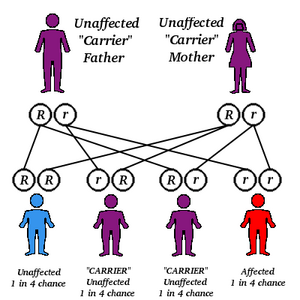Definition
Renal tubular acidosis (RTA) is a condition characterized by too much acid in the body due to a defect in kidney function.
Description
Chemical balance is critical to the body's functioning. Therefore, the body controls its chemicals very strictly. The acid-base balance must be between a pH of 7.35 and 7.45 or trouble will start. Every other chemical in the body is affected by the acid-base balance. The most important chemicals in this system are sodium, chloride, potassium, calcium, ammonium, carbon dioxide, oxygen, and phosphates.
The lungs rapidly adjust acid-base balance by the speed of breathing, because carbon dioxide dissolved in water is an acid--carbonic acid. Faster breathing eliminates more carbon dioxide, decreases the carbonic acid in the blood and increases the pH. Holding your breath does the opposite. Blood acidity from carbon dioxide controls the rate of breathing, not oxygen.
The kidneys also regulate acid-base balance somewhat more slowly than the lungs. They handle all the chemicals, often trading one for another that is more or less acidic. The trading takes place between the blood and the urine, so that extra chemicals end up passing out of the body. If the kidneys do not effectively eliminate acid, it builds up in the blood, leading to a condition called metabolic acidosis. These conditions are called renal tubular acidosis.
Causes & symptoms
There are three types of renal tubular acidosis. They include:
- Distal renal tubular acidosis (type 1) may be a hereditary condition or may be triggered by an autoimmune disease, lithium therapy, kidney transplantation, or chronic obstruction.
- Proximal renal tubular acidosis (type 2) is caused by hereditary diseases, such as Fanconi's syndrome, fructose intolerance, and Lowe's syndrome. It can also develop with vitamin D deficiency, kidney transplantation, heavy metal poisoning, and treatment with certain drugs.
- Type 4 renal tubular acidosis is not hereditary, but is associated with diabetes mellitus, sickle cell anemia, an autoimmune disease, or an obstructed urinary tract.
Symptoms vary with the underlying mechanism of the defect and the readjustment of chemicals required to compensate for the defect.
- Distal RTA results in high blood acidity and low blood potassium levels. Symptoms include mild dehydration; muscle weakness or paralysis (due to potassium deficiency); kidney stones (due to excess calcium in the urine); and bone fragility and pain.
- Proximal RTA also results in high blood acidity and low blood potassium levels. Symptoms include mild dehydration.
- Type 4 RTA is characterized by high blood acidity and high blood potassium levels; it rarely causes symptoms unless potassium levels rise so high as to cause heart arrhythmias or muscle paralysis.
Diagnosis
RTA is suspected when a person has certain symptoms indicative of the disease or when routine tests show high blood acid levels and low blood potassium levels. From there, more testing of blood and urine chemicals will help determine the type of RTA present.
Treatment
The foundation of treatment for RTA types 1 and 2 is replacement of alkali (base) by drinking a bicarbonate solution daily. Potassium may also have to be replaced, and other chemicals added to maintain balance. In type 4 RTA acidity will normalize if potassium is reduced. This is done by changing the diet and by using diuretic medicines that promote potassium excretion in the urine.
Prognosis
Careful balancing of body chemicals will usually produce good results. If there is an underlying disease responsible for the kidney malfunction, it may be the determining factor in the prognosis.
Prevention
Relatives of patients with the possibly hereditary forms of renal tubular acidosis should be tested.
Key Terms
- Autoimmune disease
- Type of diseases characterized by antibodies that attack the body's own tissues.
- Fanconi's syndrome
- A disorder of the kidneys characterized by glucose in the urine.
- Lowe's syndrome
- A rare inherited disorder that is distinguished by congenital cataracts, glaucoma, and severe mental retardation.
- Rickets
- A deficiency disease that effects the bone development of growing bodies, usually causing soft bones.
Further Reading
For Your Information
Books
- Chesney, Russell W. "Specific Renal Tubular Disorders." In Cecil Textbook of Medicine. Edited by J. Claude Bennett and Fred Plum. Philadelphia: W. B. Saunders, 1996.
Gale Encyclopedia of Medicine. Gale Research, 1999.



